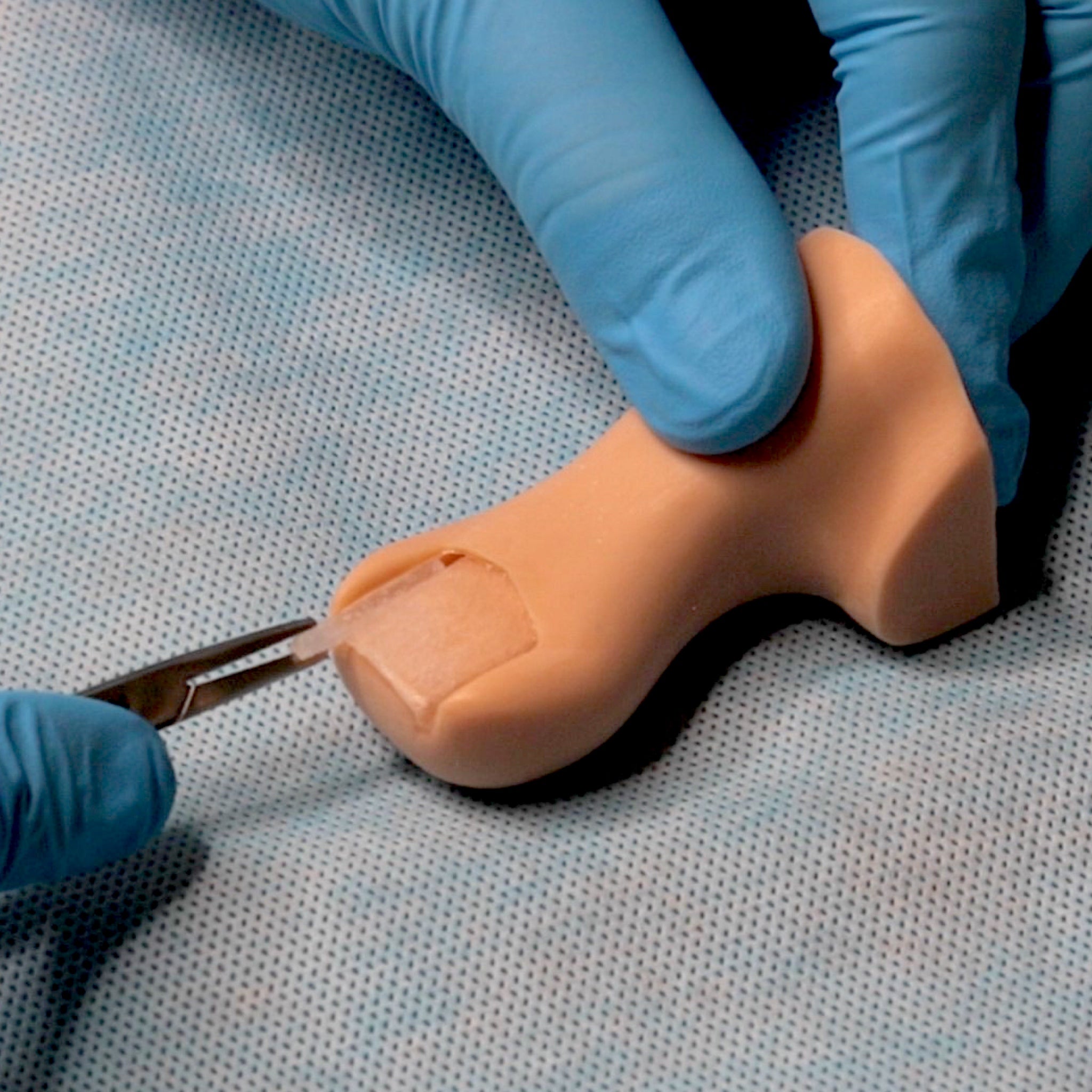

To learn more about our Ingrown Toenail Simulator click here.
IMPORTANCE OF PRACTICING THIS PROCEDURE
Primary physicians, surgeons, NPs, PAs, podiatrists and other certified professionals may encounter this ailment frequently and have the opportunity to perform simple wedge resections procedures such as lateral nail avulsion to curb the issue. Such a skill is invaluable for students and working professionals alike. Rather than referring patients to other practitioners and continually outsourcing the simple procedures of wedge resection, students and practitioners alike can easily master the necessary techniques using ingrown toenail simulators. This will save patients time and additional trips to other professionals, and in due course a clinic will be able to build clientele and positive reputation.
OVERVIEW OF INGROWN TOENAIL SEMIOLOGY, ETIOLOGY AND TREATMENT
A staggering 20% of all foot-related problems are due to ingrown toenails, otherwise known as onychocryptosis. This is an often-seen complaint wherein the nail plate folds inward into the nail bed or nail groove. The dermis of the nail groove may be penetrated by the lateral margin of the nail resulting in irritation, inflammation, edema, purulence, pain and can progress to an infection. The common symptoms of this pathology in Stage 1 are mild edema, erythema and pain when pressure is applied locally. In Stage 2, infection is more widespread, with greater inflammation, redness, pain and drainage. Finally in stage 3, all the formerly mentioned symptoms are amplified, impeding ambulation, with granulation of tissue and hypertrophy of the lateral nail-fold. Typically conservative management is advised for Stage 1, with antibiotics, elevation and warm foot baths. Partial nail avulsion is successful in treating mostly Stage 3 and some Stage 2 cases. One of the best ways to eradicate this condition in the latter stages is through excision of the lateral ¼ or ⅕ of the nail plate using nail splitter, bandage scissors or scalpel blade. The free end can be secured then removed with a clamp or hemostat, ideally in one piece. Make sure to not leave fragments of nail plate underneath the proximal nail bed, so as to avoid re-occurrence. Then matricectomy can be performed by electrocautery, or by chemical or surgical means to remove nail matrix. It is also important to advise patients to avoid wearing tight-fitting footwear and to trim their nails straight across rather than curved, in order to reduce further occurrences. Seldomly, in much more advanced cases, complete nail plate avulsion or matrixectomy may be required.
TEACHING SETTING PROBLEMS
Most students are not able to practice this procedure prior to clinicals. The only other viable options are cadavers and unrealistic simulative materials. In the first instance, cadavers offer a very limited number of practice opportunities. More often than not, there is no true ingrown toenail in the cadaveric specimen, yet the lateral avulsion technique is still performed to give the students a sense of how it is done. Otherwise, it is usually the case that the instructor will demonstrate the technique on a real ingrown toenail specimen, while the students passively watch. This severely limits the actual hands-on experience necessary for mastering this important surgical skill. On the other hand, extremely low-fidelity options such as a hotdog with a plastic nail glued-on and other unrealistic homemade simulators fail to provide the formative experience to medical trainees, which can result in poor habit formation and the subsequent need to unlearn and relearn. Practicing this skill on live patients when one is still lacking in technical experience can put a damper on patient-doctor confidence and eventual prognosis if the procedure is poorly executed.
SOLUTION TO GAINING THE PROPER SKILLS
It would greatly benefit the medical institution, and more importantly its students, to offer more hands-on exposure especially with regards to frequently encountered conditions. Oftentimes, ingrown toenail removal is only covered in theory in the didactic portion of the course and not in the clinical/simulation portion of the course. There has been a big push in recent years to increase the number of qualified procedures practitioners can bill out for. If students do not learn how to practice this procedure and do not have the opportunity to practice, they can get left behind in an increasingly competitive market. If one has never practiced this procedure in a simulated setting, it will be much harder to apply it on real patients, resulting in many professionals to refer patients elsewhere for this simple surgical procedure. Increased confidence and skill set can be readily built by practicing on realistic ingrown toenail models.
The SurgiReal Ingrown Toenail Simulator is tactically on par with a human digit in both light and dark skin tones. The toenail is ingrown on both sides with a simulated bone running through the middle and concurrent milestones so students can practice digital blocks.
To learn more about our Ingrown Toenail Simulator click here.
